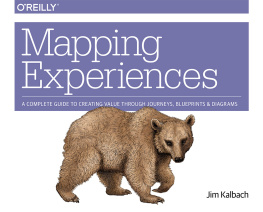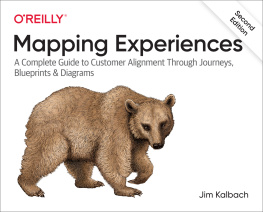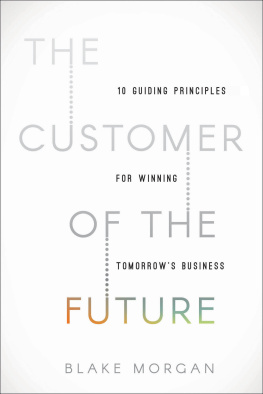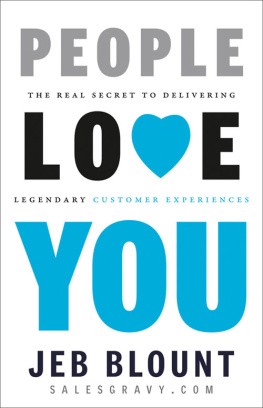Mapping Experiences
James Kalbach
Copyright 2015 James Kalbach
All rights reserved.
Published by OReilly Media, Inc., 1005 Gravenstein Highway North, Sebastopol, CA 95472.
ISBN-13: 9781491923535
9/24/15
Preface
Then the Ping-Pong match begins.
Thats what a customer told me when probing on his experience with the billing process of the company I was consulting. After digging deeper and having conversations with other customers, it became clear what he meant.
Apparently, the company was known for sending incorrect invoices. Finding a resolution often proved difficult for customers. They instinctively called the support hotline first, but agents there werent empowered to fix problems with invoices. Customers then called their sales representative, who wasnt responsible for billing issues. Relatively quickly, customers fell into an aggravating communication loop with the company.
But it got worse.
The collections department didnt suspend its scheduled warning notices. And they didnt know if a customer may have questioned an incorrect bill or not. So amidst customers frustration troubleshooting an incorrect bill, they received a past-due notice.
That not only added insult to injury, it also made the resolution exponentially more complicated: three or four parties were now involved, and the customer was caught in the middle. Ping-Pong, indeed.
This was not rare. I easily uncovered similar stories with just a handful of additional customer interviews. One person I spoke with recalled how absolutely livid she was when this happened. She was ready to cancel a service vital to her business just out of principle.
As a user experience designer, its disheartening to hear such stories. But its not surprising. Ive seen it over and over again: in large organizations, one hand does not know what the other is doing.
My research was part of a larger experience mapping project I was conducting. The effort resulted in several diagrams to illustrate customers current condition: a map of the end-to-end journey and a series of workflow diagrams illustrating their experiences step-by-step.
To conclude the project, I held a workshop with various stakeholders from a variety of functions: sales representatives, marketing specialists, business managers, designers, and developers. Walking through the illustrations allowed us to comprehend the customer experience in detail.
I intentionally put myself in the breakout group examining the billing workflowjust to see what would happen. Everything went fine until we got to the point where an incorrect bill and past-due warnings were sent out. Then came the collective outrage: how is this possible? they asked. They were unaware their company was capable of inflicting so much pain on customers.
A clear action item emerged: implement the ability to place a hold on bills that customers have challenged. This would prevent collection notices from being sent out until the issue was resolved. The head of customer care had a draft proposal for this procedure by the end of the day. Initially, this was to be done manually, but eventually an automated hold was needed.
Of course the real problem was sending incorrect invoices in the first place. But even if that were corrected, a larger, more fundamental issue emerged in our team discussion: the organization wasnt really able to handle customer complaints and requests across departments.
From this particular incident, the sales manager was easily able to recount additional stories of troubleshooting non-sales related issues with customers. This distracted him from his sales duties. And the customer care representative described how their team often couldnt help customers on the phone immediately, yet would have to take the brunt of their anger.
By coming together and having a conversation around the actual experience, we were able to reflect on the companys performance as a service provider across functions, beyond this one particular incident. It became obvious: the organization faced larger, systemic issues. These only came to light after focusing on the experience the customers point of view.
Alignment
Few organizations deliberately want to create bad experiences for the people they serve. Yet experiences like the one described above happen all the time.
I believe the fundamental problem is one of alignment: organizations are out of synch with what the people they serve actually experience.
Misalignment impacts the entire enterprise: teams lack a common purpose, solutions are built that are detached from reality, there is a focus on technology rather than experience, and strategy is shortsighted.
Aligned organizations have a shared mental model of what they are trying to accomplish. They are obsessed with delivering amazing experiences for the people they serve.
More and more, people select products and services based on the total experience they have. To meet market expectations, its imperative to align around the end-to-end experience.
To achieve alignment, I see three imperatives organizations must follow:
1. View your offerings from outside-in rather than inside-out.
From my work with dozens of companies, I have seen teams with the best intentions focused too much on internal processes. They are wrapped up in a type of organizational navel gazing. Many simply dont know what customers actually go through.
Whats needed is a change in viewpointfrom inside-out to outside-in. Organizations must have a clear understanding of the experiences they create. This is not limited to just frontline personnel. Everyone must empathize with the individuals they serve.
In this sense, gaining empathy isnt only about feeling the same emotions as another person. Instead, it refers to the ability to grasp what others are experiencing, the ability to put yourself in their shoes. Empathy for others comes with the recognition that their perspective is valid even if its different from your own.
But a little empathy is not enough. Members of the organization must deeply care about their customers and what they experience. They need to internalize peoples desires and motivations, and advocate on behalf of the people they service in everything they do.
2. Align internal functions across teams and levels.
Organizational silos prevent alignment. Aligned organizations instead work across functional boundaries. They have a relentless focus on doing whatever it takes to ensure their constituents have great experiences.
Alignment is not just about superficial improvements. Its about the collective actions of the entire group, at all levels. An organizations backstage processes have as much to do with the overall experience as the visible points of interaction that individuals encounter.
On his TV show, top chef Ramsay Gordon saves failing restaurants by re-aligning the whole establishment. He usually starts by fixing the kitchen. Hell chastise cooks for improper food storage or for having dirty exhaust hood, above the stove. The actions in the kitchen influence the experience diners have.
Aligned organizations have their kitchen in order. They move together in the same direction for the same causeto create brilliant experiences. And they dont focus on parts of the experience. They consider the end-to-end interaction. The sum of local optimizations does not guarantee optimization at the global level.
Note that alignment is already an inherent part of the business strategy vernacular. Typically managers speak of upward alignmentgetting everyone in the organization to work towards a stated strategy from above. My interpretation of the term focuses on value alignment











